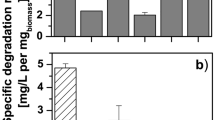Abstract
Three aerobic bacterial consortia, AC, BC, and DC, developed from pesticide-contaminated soils of Punjab were able to degrade chlorpyrifos after 21 days of incubation in basal medium by 54, 46, and 61% and chlorpyrifos (50 mg/L) in soil after 30 days by 50, 56, and 64%. Pseudomonas aeruginosa, Bacillus cereus, Klebsiella sp., and Serratia marscecens obtained from these consortia showed 84, 84, 81, and 80% degradation of chlorpyrifos (50 mg/L) in liquid medium after 20 days and 92, 60, 56, and 37% degradation of chlorpyrifos (50 mg/L) in soil after 30 days. Populations of Bacillus cereus, Klebsiella sp., and Serratia marscecens remained steady in soil experiments except for P. aeruginosa, where the population showed a substantial increase. Formation of 3,5,6-trichloro-2-pyridinol, the major metabolite of chlorpyrifos degradation, was observed during the degradation of chlorpyrifos by P. aeruginosa, which disappeared to negligible amounts.




Similar content being viewed by others
References
Bond PL, Hugenholtz P, Keller J, Blackall LL (1995) Bacterial community structures of phosphate-removing and non-phosphate-removing activated sludges from sequencing batch reactors. Appl Environ Microbiol 61:1910–1916
Bumpus JA, Kakkar SN, Coleman RD (1993) Fungal degradation of organophosphorus insecticides. Appl Biochem Biotechnol 39:715–726
Centre for Science and Environment (2003) How safe is bottled water? The Hindu, March 17
Centre for Science and Environment (2005) Pesticide cocktail poisons Punjab villagers. The Hindu, June 7
Ghanem I, Orfi M, Shamma M (2007) Biodegradation of chlorpyrifos by Klebsiella sp. isolated from an activated sludge sample of waste water treatment plant in Damascus. Folio Microbiol 52:423–427
Hirakoso S (1969) Inactivating effects of microorganisms on insecticidal activity of Dursban. Jpn J Exp Med 39:17–20
Lal S, Lal R (1987) Bioaccumulation, metabolism, and effects of DDT, fenitrothion, and chlorpyrifos on Saccharomyces cerevisae. Arch Environ Contam Toxicol 16:753–757
Mallick K, Bharati K, Banerji A, Shakil NA, Sethunathan N (1999) Bacterial degradation of chlorpyrifos in pure cultures and in soil. Bull Environ Contamin Toxicol 62:48–54
Mukherjee I, Gopal M, Dhar DW (2004) Disappearance of chlorpyrifos from cultures of Chlorella vulgaris. Bull Environ Contam Toxicol 73:358–363
Racke KD, Coats JR (1990) Enhanced biodegradation of insecticides in Midwestern corn soils. In: Racke KD, Coats JR (eds) Enhanced biodegradation of pesticides in the environment. ACS Symp Series 426. American Chemical Society, Washington, DC, pp 68–81
Sethunathan N, Pathak MD (1972) Increased biological hydrolysis of diazinon after repeated application in rice paddies. J Agr Food Chem 20:586–589
Singh BK, Walker A, Morgan JAW, Wright DJ (2004) Biodegradation of chlorpyrifos by Enterobacter strain B–14 and its use in bioremediation of contaminated soils. Appl Environ Microbiol 70:4855–4863
Singh BK, Walker A (2006) Microbial degradation of organophosphorus compounds. FEMS Microbiol Rev 30:428–471
Singh BK, Walker A, Morgan JAW, Wright DJ (2003) Effects of soil pH on the biodegradation of chlorpyrifos and isolation of a chlorpyrifos-degrading bacterium. Appl Environ Microbiol 69:5198–5206
Yang L, Zhao YH, Zhang BX, Yang CH, Zhang X (2005) Isolation and characterization of a chlorpyrifos and 3,5,6-trichloro-2-pyridinol degrading bacterium. FEMS Microbiol Lett 251:67–73
Acknowledgment
This research was supported by a grant from the Department of Biotechnology (DBT), New Delhi, India.
Author information
Authors and Affiliations
Corresponding author
Rights and permissions
About this article
Cite this article
Vidya Lakshmi, C., Kumar, M. & Khanna, S. Biodegradation of Chlorpyrifos in Soil by Enriched Cultures. Curr Microbiol 58, 35–38 (2009). https://doi.org/10.1007/s00284-008-9262-1
Received:
Revised:
Accepted:
Published:
Issue Date:
DOI: https://doi.org/10.1007/s00284-008-9262-1




